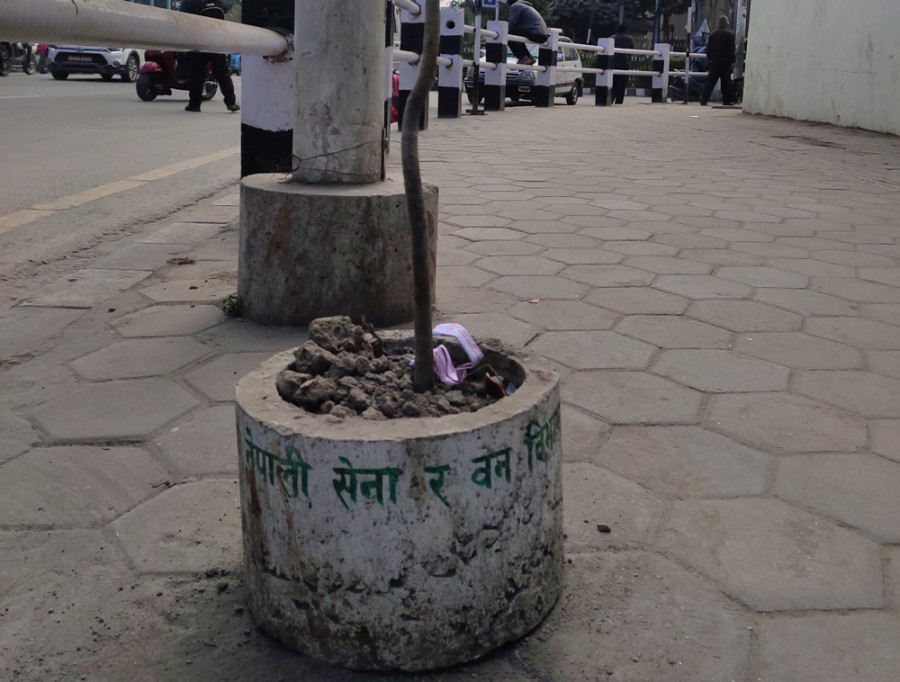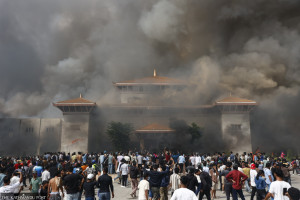Kathmandu
Saplings planted in front of Nepal Army headquarters and City Office wither
Botanists say city is planting saplings on as if they are planting trees in forests that don’t need much care.
Anup Ojha
Conservationists, botanists and commoners have criticized the city authorities for their negligence and lack of proper studies before planting saplings on the roadsides in the name of promoting greenery in the Valley.
Nearly two months ago, Kathmandu Metropolitan City in partnership with the Nepal Army and Department of Environment planted 500 plants on the footpaths starting from Tripureshwor to Jamal, but more than 60 percent of the plants have already died due to lack of care.
Recently, after the saplings had been planted, Nepal Army spokesperson Brig Gen Bigyan Dev Panday had assured that the Army would look at those plants until they are fully grown. Panday even shared the success record of the Army planting 98,556 plants in its barracks and their surroundings in all seven provinces.
The authorities had planted Bottlebrushes and Jacaranda. Botanists say these tropical plants can easily survive on Kathmandu roads as they are adoptive plants.
“Saplings that are planted for roadside beautification should be planted with great care. But, these saplings were planted as if they were planting trees in a forest where the success rate didn’t matter,” said Tritha Bahadur Shrestha, a botanist and conservationist. He said that it was unfortunate to see a lack of farsightedness in the city authorities.
“In a forest, if only 30 percent plants survive, it would be meaningful, but planting in a city should give 100 percent results,” said Shrestha. “They have planted trees in cemented narrow alleys, how can plants survive in such places.”
On Tuesday, when the Post visited Sundhara, dozens of saplings planted just in front of the entry gate of the Nepal Army headquarters and Kathmandu Metropolitan City in Sundhara looked withered, and many plants were missing from flower vessels and those that remained were being pilfered by the pedestrians. In many places, one could only notice empty cemented pots painted in white colour with the names of Nepal Army, Kathmandu Metropolitan City and Environment Division.
“What could be a greater irony than this? Plants that were planted in front of their office gates are dying. How can they think of preserving saplings in other areas?” said Rajan Dahal, 45, owner of Makalu Yatayat in Sundhara.
“They are dying due to lack of water and proper gardening. I have been pouring water in a sapling planted in front of my office, but it has also died,” said Dahal, adding that seeing Army’s involvement he was convinced that those saplings would survive.
Starting from Sundhara area, footpaths at Shahid Gate, Bir Hospital, Ratnapark and Ranipokhari all the way to Jamal, the condition of the planted saplings was pathetic.
Hari Bahadur Shrestha, the chief at the City Office’s Environment Division, said his office did not have to spend on the plantation as the plants were provided by the Department of Plant Resources. “The plants have died as we could not place tree guards as the supplying company didn’t deliver at the time of plantation,” Shrestha lamented.
In January, saplings planted along the Kalanki-Koteshwor road had met the same fate due to the authority’s apathy in the preservation of the plants. The Ministry of Forest and Environment had planted 2,681 saplings along the stretches after the Post repeatedly wrote about the issue. Lalitpur Metropolitan City had taken charge of regular supervision and regular watering of the plants.




 10.12°C Kathmandu
10.12°C Kathmandu.jpg)











